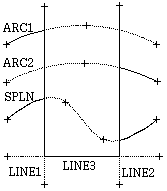Overview | Statement List | Example
obj = CRVTRM/curve,REF, {pt1|x,y,z},FIRST,limit1[,REF,{pt1|x,y,z}] [,INT,{pt2|x,y,z}][,NOTRIM][,SECOND,limit2 [,REF,{pt1|x,y,z}][,INT,{pt2|x,y,z}][,NOTRIM]] ,STATUS,status[,IFERR, label:]
Allows you to trim an existing curve using one or two bounding objects such as points, curves, and faces.
![]() NOTE: A null object (&NULENT) is returned unless the curve is
trimmed into two segments. If you remove the center part of a curve and allow
the two ends of the curve to remain, then one end retains the original object
identifier and the other end receives an object identifier which is returned by
the CRVTRM command.
NOTE: A null object (&NULENT) is returned unless the curve is
trimmed into two segments. If you remove the center part of a curve and allow
the two ends of the curve to remain, then one end retains the original object
identifier and the other end receives an object identifier which is returned by
the CRVTRM command.
|
Parameter |
Description |
|
curve |
An existing curve to be trimmed. |
|
REF |
Minor word indicating that a reference point follows. That reference point can either be a point object, or three coordinates. The segment of the curve that is closest to the reference point is trimmed when you have a single bounding curve. When you have two bounding curves there are two cases that can occur: the reference point is inside the bounding curves or outside the bounding curves. In Figure below, the two straight lines are the bounding curves and the arc is the curve to trim. The "plus" signs indicate the reference points. When the reference point is outside the bounding curve, all segments outside the bounding curves are trimmed. When the reference point is inside the bounding curves, all segments inside the bounding curves are trimmed.
CRVTRM with Two Bounding Curves |
|
pt1 |
An existing reference point object that defines what section of the curve is removed or extended. |
|
x,y,z |
Coordinates specifying a reference point if an existing point is not used. |
|
FIRST |
Required minor word indicating that the first bounding object follows. |
|
limit1 |
Specifies the first boundary object. |
|
REF |
Minor word indicating that a reference point follows. That reference point can either be a point object, or three coordinates. |
|
pt1 |
An existing reference point object that defines what end of the curve is removed. |
|
x,y,z |
Coordinates specifying a reference point if an existing point is not used. |
|
INT |
Optional minor word indicating that a reference point for the intersection between the curve and the bounding object follows. The reference point is used when multiple intersections exist. That reference point can either be a point object or three coordinates. |
|
pt2 |
An existing reference point object for the intersection between the curve and the bounding object. |
|
x,y,z |
Coordinates specifying a reference point if an existing point is not used. |
|
NOTRIM |
Optional minor word indicating not to trim the associated bounding object. If the bounding object is not a curve (i.e. a point or face), then no trim is performed whether NOTRIM is used or not. |
|
SECOND |
Optional minor word indicating that the second bounding object follows. |
|
limit2 |
Specifies the second boundary object. |
|
REF |
Minor word indicating that a reference point follows. That reference point can either be a point object, or three coordinates. |
|
pt1 |
An existing reference point object that defines what end of the curve is removed. |
|
x,y,z |
Coordinates specifying a reference point if an existing point is not used. |
|
INT |
Optional minor word indicating that a reference point for the intersection between the curve and the bounding object follows. The reference point is used when multiple intersections exist. That reference point can either be a point object or three coordinates. |
|
pt2 |
An existing reference point object for the intersection between the curve and the bounding object. |
|
x,y,z |
Coordinates specifying a reference point if an existing point is not used. |
|
NOTRIM |
Optional minor word indicating not to trim the associated bounding object. If the bounding object is not a curve (i.e. a point or face), then no trim is performed whether NOTRIM is used or not. |
|
STATUS |
Required minor word indicating a trim status value follows. |
|
status |
Required variable which indicates the trim status value as follows: -5 = invalid
boundary object |
|
IFERR,label: |
Specifies a label to which program execution jumps if an error occurs during trim. This is optional. |
The CTRIM statement allows you to trim a curve by a specified arclength.

Results of CRVTRM Example